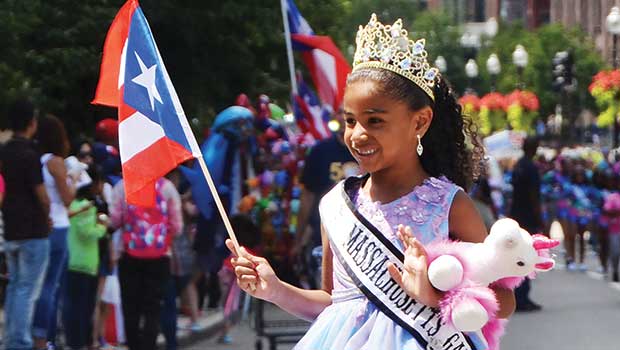Boston’s Puerto Rican festival: A 50-year tradition
Music, culture of the island celebrated at City Hall

Priscilla Jiminez hadn’t had much experience with beauty pageants when she began competing for queen of this year’s Puerto Rican Festival. But she had the best possible coach: Anastasia Correa, who in 1967 was queen of the first-ever festival.
Correa, who has helped generations of queens and would-be queens compete for the honor of riding on the royal parade float, herself received almost no instruction for the 1967 festival.
“They said, ‘Just smile and wave.’”
That was intimidating for Correa, who was then a student at the Charles E. Mackey elementary school, but she climbed in the back of a yellow convertible that led the parade down Tremont Street, past the apartment where she lived, en route to Blackstone Park. She wore a tiara and a long dress.
“Everything was hand-made,” she recalls.
Fifty years later, the festival has become a mainstay for Boston’s Puerto Rican community, and one of the largest cultural festivals in the city. Sunday, the festival featured an all-star lineup of musical acts, including salsa legend Tony Vega. Today’s Puerto Rican festival draws thousands of people from throughout Massachusetts — a far cry from the original 1967 festival.
That event was organized by a group of 15 volunteers who solicited donations from local businesses.
“The good thing about it was that everybody was united,” Correa says. “This is what the festival is really about. People coming together.”
A crowd estimated at 2,500 people turned out for the first festival. Over the years, the event moved to venues including City Hall Plaza, Roberto Clemente Park in the Fenway, Franklin Park and then back to City Hall Plaza. Now elected officials and candidates march in the parade along with cultural and dance groups, tricked-out bikes and classic cars — and the queens.
At the first festival, local musicians in the Puerto Rican community, which then was centered in the South End, played traditional music from the island — bombas, plenas and other folk music forms. In the pre-salsa days of 1967, Afro-Cuban guaguanco and mambo were the dominant music and dance styles in Puerto Rican communities, Correa recalls.
“That’s what we grew up with,” she says.
Nowadays salsa competes with reggaetón on the bandstand. But the traditional Puerto Rican folk music still holds its own.
Like Correa, many of those in attendance at last weekend’s festival have been attending for decades.
“There’s a lot more people now than before,” said Mirta Perez, who came to Boston from the city of Loiza 30 years ago. “The food is still good and so is the music. It reminds me of Puerto Rico.”
Standing in front of the stage with a Puerto Rican flag painted on each of his cheeks, a straw hat with “Puerto Rico” printed on the front, a pair of Puerto Rican flags on his sunglasses, flags on his do-rag and a beaded flag around his neck, Roxbury resident Edwin Rivera held aloft a full-sized Puerto Rican flag.
“Yo soy Boricua!(I am a Puerto Rican),” shouted an announcer on the stage. “Pa’ que tu lo sepa! (so you know),” shouted Rivera and thousands of others on City Hall Plaza in response.
“I never miss a year,” Rivera said. “I never miss a day.”







